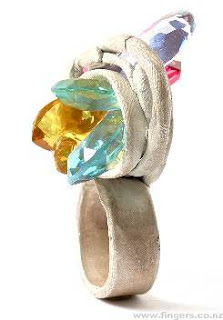
I'm searching for his curriculum vitae, his background, his philosophy. But he's a mysterious man, there's nothing much out there. I know that he's German, born in 1963 and had his first show in 1997 (I think). But his jewelry education and early work is mostly lost to time.

I'm intrigued by his celebrity, the number of galleries who seem to be impressed with his work, the respect he seems to garner. And I wonder... if a metal clay artist made items exactly like this what would the world think?

I'm pretty sure the "traditional jewelry community" would regard them as crass crafters, talentless hacks and lazy technicians. For goodness sakes the jewels are GLUED in place, there are visible fingerprints, edges are ragged and the construction is just plain sloppy.

And yet Mr Fritsch's work demands high prices. And so I wonder - when does seemingly poor craftsmanship become kitch or innovative or ground breaking? Is intention such an important component in creation that it overrides common sense? Or is the art world sometimes just a little too impressed with itself, reaching to find the beauty in ugliness.

And yet I do see beauty in some of his designs. And the designs of the following artists. What is it that separates them? Popularity? Good press? Celebrity? A degree? A political opinion they feel compelled to state?

Metal Clay ring by Anne Dinan

Metal And Polymer Clay ring by Sous la Mansarde
At first glance work like this seems less than stellar, but upon closer examination there is something I find intriguingly attractive. Something that makes me think. And isn't that what "art" is ultimately supposed to do? Touch us in a way that opens our minds to the unexpected?

Metal Clay ring by Sister Wicked

Metal Clay Pebble Ring by Amy Honeybee

8 comments:
I'm taking my response off-line (because it's going to be long). I'll email you. I definitely have thoughts on this.
In summary though, I do think it all has to do with popularity, celebrity, and the self-aggrandizement of the art world. Although, I will say that I'm sure that what you see as signs of shoddy craftsmanship are "supposed" to be intentional characteristics of his work. ::smirk::
Verrrry interesting topic, Pandora's Box that it is. lol!
I'll hit you up offline. I'm still trying to figure out how I feel about such things--and how to state my feelings constructively.
Oh, I know that Karl's "shoddy" appearance is intentional. And that the "shoddy" appearance of some metal clay artist's work is NOT intentional, but the result of inattention or lack of skill.
That doesn't really change the way the camera sees the finished work. So obviously our prejudices one way or the other color our opinions for the better or for the worse. And I wonder, if judged simply on the merit of the work itself.. What's the difference? And why does intent elevate something less than... polished (shall we say) to gallery/museum worthiness?
I've decided! I'm going to intend some of my pieces were supposed to look that way. I might go back and add a touch or two to really set the intention. LOL But I dig what you are saying and have often wondered this myself when viewing other "celebrity" art. ???
Excellent post Lora!
Yes, absolutely excellent post !
I had a student a couple of years ago send me a catalog of a show he was in which took part in the South of France simply because she swore it was metal clay :)
I have a couple of opinions on this myself. It would be a long discussion over many cups of capuccino ;o)
To be able to make a statement though, I'd be interested in seeing earlier work of his.
Like, Picasso and Miro actually knew how to draw very well figuratively first, then it became a freedom of style and expression which pushed the walls of their time ...
I'm not really into "modern" art, and simply looove the earrrly work of Picasso. School age work. He was really a very talented fine artist before he branched out into his later, and more popular work.
I saw him speak at SNAG a couple years ago. He actually lit up a cigarette while he was presenting. He seems to have become famous with a chewing gum piece he did where he would send clients gum. They chew it and send it back to him and he cast it. He then took a mercedes and cut it up and made it into pins. Then people started driving their cars into his studio to be cut into a pin. His stuff is not metal clay but cast. He does lots of resin stuff too with guns inside the resin, found jewelry and things. I think the more out there you are, the more you can create a brand. He has definitely created that brand. It's marketing. He is traditionally trained in the european goldsmith methods. So if his work looks "shoddy", it's on purpose. He definitely was an interesting character. The press loves him as well as the public.
I used to teach writing to fourth graders. I told them there was no such thing as a grammar rule that couldn't be broken. (Don't believe me? Read James Joyce.) But if they had a run-on sentence or fragment or whatever, they had to be able to tell me how it added to their story to "break the rules." I'd accept poor grammer for the sake of effect, but not simply because they didn't know any better. I think the same can be said for art. The trick, of course, is knowing the intent.
I actually quite like the first piece of his that's shown in your blog.
Post a Comment